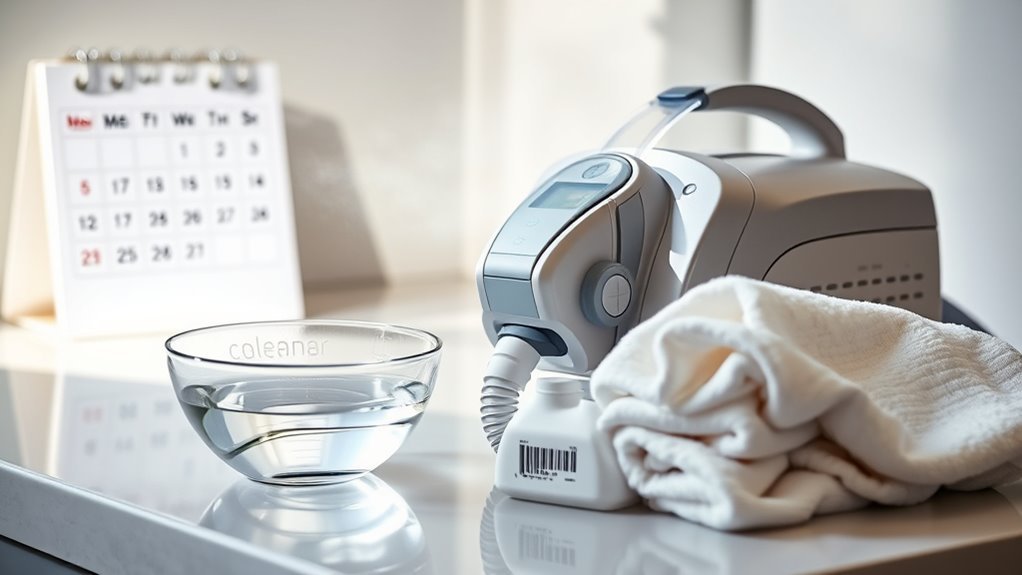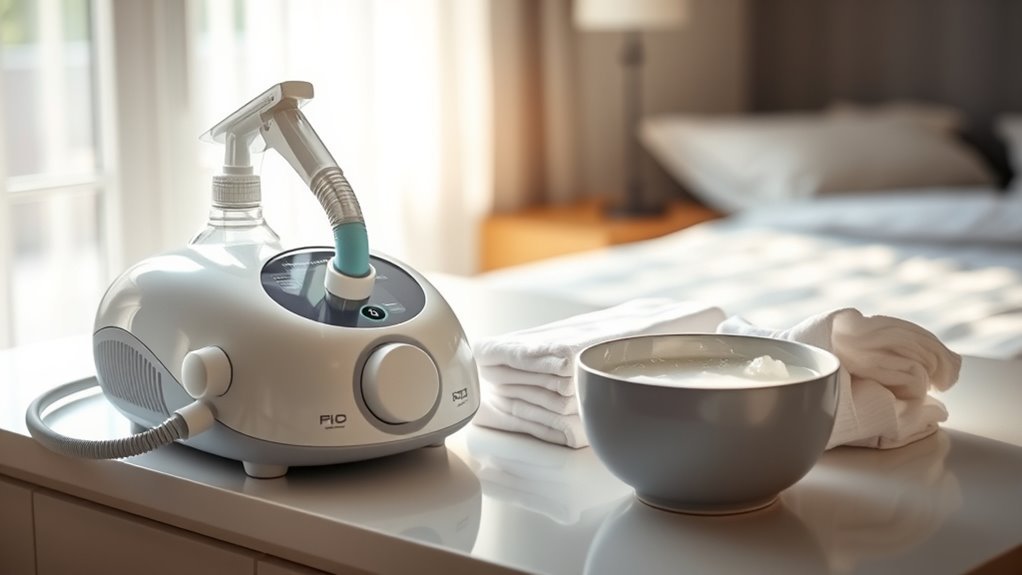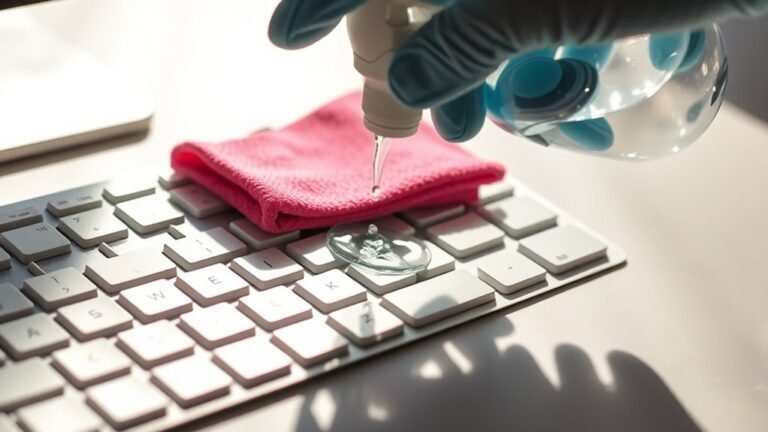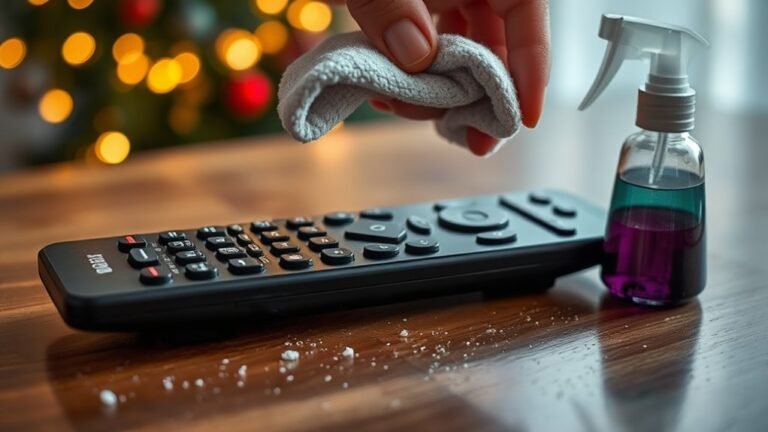Cleaning and Disinfecting CPAP Machines for Sleep Apnea
You should clean your CPAP machine daily, focusing on the mask and tubing with mild soap and warm water to prevent bacteria buildup. Weekly, disinfect all parts, including the humidifier chamber, using approved solutions like 70% isopropyl alcohol or 3% hydrogen peroxide, following the manufacturer’s guidelines. Avoid harsh chemicals and never soak electronic parts. Proper drying and storage help prevent mold and extend equipment life. Keep these steps in mind to maintain your device’s safety and effectiveness—there’s more to learn about ideal care.
Importance of Regular CPAP Cleaning

Keeping your CPAP machine clean is crucial for both your health and the device’s performance. When you maintain good CPAP hygiene, you reduce the risk of infections and respiratory issues that can worsen your sleep apnea symptoms. A dirty machine can harbor bacteria, mold, and allergens, which not only affect your breathing but also compromise the freedom you seek through restful sleep. Regular cleaning guarantees your device functions effectively, delivering consistent air pressure that keeps your airway open. By committing to a simple routine, you protect yourself from potential health setbacks and preserve your independence in managing sleep apnea. Staying diligent with CPAP hygiene means you won’t have to worry about interruptions in your sleep therapy or your well-being.
Components of a CPAP Machine That Need Cleaning
Several key components of your CPAP machine require regular cleaning to maintain peak performance and hygiene. You’ll want to focus on the mask, tubing, humidifier chamber, and filters. The mask collects oils and sweat, so it needs gentle washing with suitable cleaning tools. The tubing can accumulate moisture and bacteria, making it essential to rinse and dry thoroughly. The humidifier chamber holds water, which can foster mold if neglected. Filters trap dust and allergens, so swapping or cleaning them helps maintain airflow quality. Paying attention to cleaning frequency maintains these parts stay fresh and safe without hassle. By keeping these components clean, you’re freeing yourself from risks and guaranteeing your CPAP works efficiently every night.
Recommended Cleaning Frequency for CPAP Equipment

You should clean your CPAP mask and tubing daily to prevent bacteria buildup and keep your therapy effective. Once a week, it’s important to do a deeper disinfection of all parts, including the humidifier chamber. Sticking to this routine helps guarantee your equipment stays safe and working well.
Daily Cleaning Importance
Although it might seem tedious, cleaning your CPAP equipment daily is essential to prevent bacteria buildup and guarantee effective therapy. Making it part of your daily routine helps you maintain good hygiene habits without hassle. Just a quick rinse of the mask, tubing, and water chamber with warm, soapy water keeps germs at bay and assures your machine works properly every night. Skipping this step can lead to infection, discomfort, and reduced machine efficiency, limiting your freedom to breathe easy. By sticking to daily cleaning, you’re protecting your health and maximizing your CPAP’s performance. It doesn’t take long, but the impact on your well-being is significant, giving you the confidence to enjoy restful sleep night after night.
Weekly Deep Disinfection
Keeping up with daily cleaning is a great start, but your CPAP equipment also needs a more thorough disinfection once a week. Sticking to a weekly maintenance routine guarantees your machine stays free from harmful bacteria and mold, giving you the freedom to breathe easy every night. To fit this into your disinfection schedule, focus on these key steps:
- Soak the mask, tubing, and humidifier chamber in a CPAP-safe disinfectant solution.
- Rinse everything thoroughly with warm water to remove any residue.
- Let all parts air dry completely before reassembling.
Step-by-Step Guide to Cleaning CPAP Masks
Cleaning your CPAP mask properly is essential for maintaining hygiene and ensuring the device works effectively. Start by detaching the mask from the machine. Use warm water and mild soap to gently wash the mask, paying attention to different mask materials—silicone, gel, or fabric—since each requires a gentle touch. Avoid harsh chemicals that can damage the mask. Rinse thoroughly to remove soap residue. Let the mask air dry completely on a clean towel, avoiding direct sunlight which can degrade materials. Regular cleaning techniques like daily wiping and weekly deep washing will keep your mask fresh and comfortable. By following these simple steps, you maintain your freedom to breathe easy without worrying about germs or irritation from a dirty mask.
How to Clean CPAP Tubing Effectively

To keep your CPAP tubing in top shape, you’ll want to follow daily maintenance routines that prevent buildup. Occasionally, a deeper cleaning with soap and water is necessary to remove any stubborn residue. Make sure to dry the tubing completely before storing it to avoid mold and bacteria growth.
Daily Maintenance Tips
Every day, you should give your CPAP tubing a thorough rinse to prevent buildup of bacteria and mold. Keeping it clean doesn’t have to be a chore; with some user-friendly tips, you can maintain freedom from worries about hygiene. If traditional cleaning feels cumbersome, consider alternative cleaning methods like using mild soap or vinegar solutions, which are effective and simple.
Here are three daily maintenance tips to keep your tubing fresh:
- Rinse tubing with warm water after each use to flush out moisture.
- Hang tubing vertically to air dry completely, avoiding dampness.
- Avoid harsh chemicals that can damage tubing; stick to gentle cleaners.
Deep Cleaning Methods
One of the most effective ways to keep your CPAP tubing in top condition is by performing a deep clean at least once a week. Start by disconnecting the tubing and soaking it in warm water mixed with mild soap or a specialized CPAP cleaning solution. Use deep cleaning techniques like gently scrubbing the inside with a flexible brush designed for tubing. This helps remove any built-up residue or bacteria that daily wipes might miss. After scrubbing, rinse thoroughly to guarantee no soap remains, which could irritate your airways. Effective sanitization is key to preventing mold, bacteria, and odors. Regularly practicing these deep cleaning methods frees you from worry and keeps your CPAP system working smoothly, supporting your health and freedom to breathe easy every night.
Drying and Storage
After thoroughly cleaning your CPAP tubing, confirming it dries completely before storage is just as important to prevent mold and bacteria growth. You want to embrace effective drying techniques that keep your equipment fresh and safe. Start by hanging the tubing vertically, allowing gravity to help drain any remaining moisture. Avoid direct sunlight, which can degrade the material. When it comes to storage solutions, choose a clean, dry place away from dust and pets. Consider these tips:
- Use a dedicated, breathable storage bag to keep your tubing protected.
- Store tubing loosely coiled to avoid kinks and damage.
- Confirm the storage area has good air circulation to maintain dryness.
Proper Maintenance of CPAP Humidifier Chambers
Keeping your CPAP humidifier chamber clean is essential for both your health and the machine’s performance. Proper humidifier care prevents mold, bacteria buildup, and guarantees consistent moisture delivery. Start by emptying any leftover water daily and rinsing the chamber with warm, soapy water. Avoid harsh cleaners that could damage the material. After washing, let it air dry completely before reassembling. Regularly inspect the chamber for cracks or discoloration—replace it when needed to keep your therapy safe and effective. These simple maintenance tips free you from worries about contamination and help your CPAP machine work smoothly every night. Staying on top of your humidifier chamber care means you can enjoy restful sleep without hassle or health risks.
Safe Disinfectants for CPAP Machines and Accessories
When cleaning your CPAP machine and accessories, it’s important to use disinfectants that are approved and safe for these devices. You’ll want to avoid harsh chemicals that could damage the equipment or irritate your skin and lungs. Applying disinfectants properly guarantees your machine stays clean without compromising its function.
Approved Disinfectant Types
Choosing the right disinfectants is essential to guarantee your CPAP machine and accessories stay clean without getting damaged. When exploring disinfectant options, you want effective solutions that protect your health and your device. Here are approved disinfectant types you can confidently use:
- Isopropyl alcohol (70%): A reliable choice that quickly kills germs without leaving residue.
- Hydrogen peroxide (3%): Gentle yet effective for disinfecting masks and tubing.
- Mild dish soap with warm water: Perfect for daily cleaning to remove oils and debris before disinfecting.
These options keep your CPAP equipment safe and hygienic while supporting your freedom to breathe easy. Always follow manufacturer guidelines to maintain your device’s longevity and performance.
Avoiding Harmful Chemicals
Although disinfecting your CPAP machine is essential, you shouldn’t use harsh chemicals that could damage your equipment or irritate your skin and lungs. Staying free from harmful substances means embracing chemical awareness—knowing what’s safe and what’s not. Opt for natural alternatives like vinegar diluted with water or mild, fragrance-free soap to keep your machine clean without risking damage. These options effectively disinfect without leaving toxic residues that could affect your health or the longevity of your CPAP. Avoid bleach, ammonia, or alcohol-based cleaners, as they can degrade materials and cause irritation. By choosing gentle, natural disinfectants, you maintain your freedom to breathe easy and enjoy a clean, safe therapy experience every night. Your health and machine deserve that careful attention.
Proper Application Techniques
Since safe disinfectants are key to maintaining your CPAP machine, knowing how to apply them properly guarantees both effective cleaning and equipment longevity. When choosing your application methods, focus on techniques that protect your device while thoroughly eliminating germs. Use gentle, non-abrasive approaches to avoid damage.
Here are three essential cleaning techniques to keep in mind:
- Apply disinfectants with a soft cloth or sponge to prevent scratching.
- Avoid soaking electronic components; instead, use dampened cloths for targeted cleaning.
- Rinse thoroughly with water where appropriate to remove residue and prevent buildup.
Common Mistakes to Avoid When Cleaning CPAP Equipment
When cleaning your CPAP equipment, it’s easy to make mistakes that can reduce its effectiveness or even cause damage. One of the most common misconceptions is using harsh chemicals or household cleaners, which can degrade the materials. Another frequent oversight is neglecting to clean all parts regularly, especially the tubing and mask cushions, where bacteria tend to build up. You might also be tempted to skip drying parts thoroughly, but lingering moisture invites mold growth. Avoid immersing the machine’s motor or electronic components in water, as this can cause irreparable harm. By steering clear of these pitfalls, you maintain your CPAP’s performance and protect your health—giving you the freedom to breathe easy every night without worry.
Tips for Drying and Storing CPAP Parts
After cleaning your CPAP equipment, properly drying and storing each part is just as important to keep everything in good shape. Using effective drying techniques guarantees no moisture lingers, preventing mold and bacteria growth. Here are some tips to help you maintain freedom from equipment issues:
Proper drying and storage of CPAP parts prevents moisture buildup, mold, and bacteria for lasting equipment care.
- Air-dry parts on a clean, lint-free towel in a well-ventilated area, avoiding direct sunlight that can damage materials.
- Use storage solutions like breathable bags or dedicated containers that keep dust away without trapping moisture.
- Avoid sealing damp parts in airtight containers, as this promotes bacterial growth and odors.
When to Replace CPAP Components for Optimal Hygiene
Knowing how often to replace your CPAP components is key to keeping your equipment clean and effective. Staying on top of the component lifespan guarantees you meet hygiene standards and breathe freely without worry. Replace parts before wear and tear trap germs or reduce performance, so your therapy stays safe and liberating.
| Component | Recommended Replacement Interval |
|---|---|
| Mask Cushion | Every 1-3 months |
| CPAP Tubing | Every 3 months |
| Filters | Every 2 weeks or monthly |
Frequently Asked Questions
Can I Clean My CPAP Machine With Vinegar or Bleach?
You might think vinegar is a simple way to clean, and it does have some benefits like being natural and effective against bacteria. However, bleach dangers can’t be ignored—it’s too harsh and can damage your equipment or leave harmful residues. To keep your freedom and health intact, stick to manufacturer-approved cleaning solutions. They’re designed to clean safely without risking your CPAP machine’s performance or your well-being.
How Do Travel CPAP Cleaners Differ From Home Cleaning Methods?
Travel CPAP cleaners offer portable sanitization, designed for your on-the-go lifestyle. Unlike traditional home methods that might require larger equipment or longer drying times, these devices are compact and quick, giving you travel convenience without sacrificing cleanliness. They use technologies like UV light or activated oxygen to keep your machine fresh, so you can enjoy freedom from bulky setups and still maintain hygiene wherever you roam.
Is It Safe to Use a Dishwasher for CPAP Parts?
Throwing your CPAP parts into the dishwasher might seem like a breeze, but when it comes to dishwasher safety, it’s a risky adventure. The heat and harsh detergents can warp or damage delicate components, compromising CPAP maintenance. If you crave freedom from tedious cleaning, stick to gentle hand washing with mild soap and air drying. That way, you keep your equipment safe and your nights worry-free.
Can Pets Affect the Cleanliness of CPAP Equipment?
Yes, pets can definitely affect the cleanliness of your CPAP equipment. Pet hair easily clings to fabrics and surfaces, increasing the risk of contamination. If you have allergy concerns, this can make your breathing experience less comfortable or even trigger symptoms. To keep your gear fresh and safe, you’ll want to store it away from your pets and clean it regularly. That way, you can enjoy both your furry friends and your freedom to breathe easy.
Are There Any Risks of Mold Growth in CPAP Machines?
Yes, mold growth can happen in CPAP machines if moisture isn’t controlled, posing serious health risks like respiratory issues. To keep your equipment safe, mold prevention is key. You’ll want to regularly dry and clean the parts, especially the water chamber, to avoid mold buildup. Staying proactive means you’re free to enjoy restful sleep without worrying about hidden dangers lurking in your machine.






